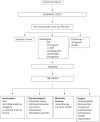Chyluria: what does the clinician need to know?
- PMID: 32728391
- PMCID: PMC7366404
- DOI: 10.1177/1756287220940899
Chyluria: what does the clinician need to know?
Abstract
Chyluria is secondary to the presence of chyle in the urine. The classical appearance on inspection is of milky white urine, which is caused by a fistulous communication between the lymphatic system and the urinary tract. Worldwide, it is most commonly associated with the parasite Wuchereria bancrofti, which is prevalent in Asia, most extensively in India but also China and Taiwan. However, in the United Kingdom, Europe and North America, where the condition is rare, non-parasitic aetiologies predominate. Chyluria is occasionally associated with other urinary tract symptoms including infection, loin pain and haematuria. It may also cause hypoproteinaemia, weight loss and cachexia. Management is based on identifying the aetiology and depends on the severity of the chyluria and presence of associated symptoms. Given its predominate symptom being urinary, cases in the West can fall under the care of the urologist. The aim of this article is to provide an overview and summary of the aetiology, assessment and management of chyluria based on the most up-to-date evidence available. This was achieved through a non-systematic review of world literature.
Keywords: chyluria; infection; kidney; lymphangiography; sclerotherapy.
© The Author(s), 2020.
Conflict of interest statement
Conflict of interest statement: The authors declared no potential conflicts of interest with respect to the research, authorship, and/or publication of this article.
Figures
References
-
- Jones RT. Non-endemic cases of lymphatic filariasis. Trop Med Int Health 2014; 19: 1377–1383. - PubMed
-
- Abeygunasekera AM, Sutharshan K, Balagobi B. New developments in chyluria after global programs to eliminate lymphatic filariasis. Int J Urol 2017; 24: 582–588. - PubMed
-
- Komeya M, Sahoda T, Sugiura S, et al. Chyluria after partial nephrectomy: a rare but considerable complication. Int J Urol 2013; 20: 242–245. - PubMed
Publication types
LinkOut - more resources
Full Text Sources


